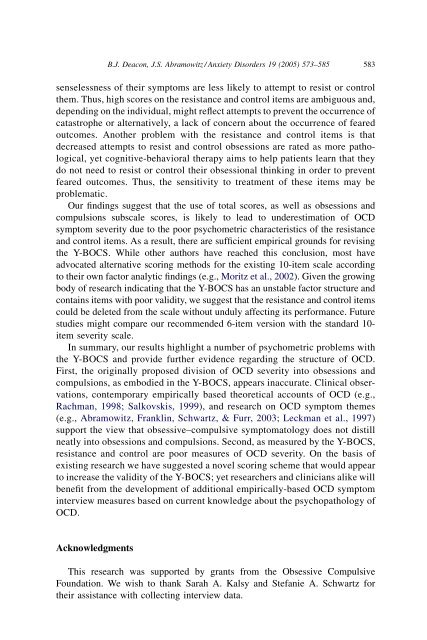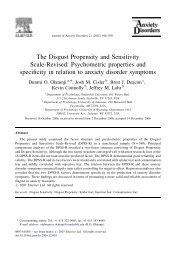The Yale-Brown Obsessive Compulsive Scale - University of ...
The Yale-Brown Obsessive Compulsive Scale - University of ...
The Yale-Brown Obsessive Compulsive Scale - University of ...
Create successful ePaper yourself
Turn your PDF publications into a flip-book with our unique Google optimized e-Paper software.
B.J. Deacon, J.S. Abramowitz / Anxiety Disorders 19 (2005) 573–585 583senselessness <strong>of</strong> their symptoms are less likely to attempt to resist or controlthem. Thus, high scores on the resistance and control items are ambiguous and,depending on the individual, might reflect attempts to prevent the occurrence <strong>of</strong>catastrophe or alternatively, a lack <strong>of</strong> concern about the occurrence <strong>of</strong> fearedoutcomes. Another problem with the resistance and control items is thatdecreased attempts to resist and control obsessions are rated as more pathological,yet cognitive-behavioral therapy aims to help patients learn that theydo not need to resist or control their obsessional thinking in order to preventfeared outcomes. Thus, the sensitivity to treatment <strong>of</strong> these items may beproblematic.Our findings suggest that the use <strong>of</strong> total scores, as well as obsessions andcompulsions subscale scores, is likely to lead to underestimation <strong>of</strong> OCDsymptom severity due to the poor psychometric characteristics <strong>of</strong> the resistanceand control items. As a result, there are sufficient empirical grounds for revisingthe Y-BOCS. While other authors have reached this conclusion, most haveadvocated alternative scoring methods for the existing 10-item scale accordingto their own factor analytic findings (e.g., Moritz et al., 2002). Given the growingbody <strong>of</strong> research indicating that the Y-BOCS has an unstable factor structure andcontains items with poor validity, we suggest that the resistance and control itemscould be deleted from the scale without unduly affecting its performance. Futurestudies might compare our recommended 6-item version with the standard 10-item severity scale.In summary, our results highlight a number <strong>of</strong> psychometric problems withthe Y-BOCS and provide further evidence regarding the structure <strong>of</strong> OCD.First, the originally proposed division <strong>of</strong> OCD severity into obsessions andcompulsions, as embodied in the Y-BOCS, appears inaccurate. Clinical observations,contemporary empirically based theoretical accounts <strong>of</strong> OCD (e.g.,Rachman, 1998; Salkovskis, 1999), and research on OCD symptom themes(e.g., Abramowitz, Franklin, Schwartz, & Furr, 2003; Leckman et al., 1997)support the view that obsessive–compulsive symptomatology does not distillneatly into obsessions and compulsions. Second, as measured by the Y-BOCS,resistance and control are poor measures <strong>of</strong> OCD severity. On the basis <strong>of</strong>existing research we have suggested a novel scoring scheme that would appearto increase the validity <strong>of</strong> the Y-BOCS; yet researchers and clinicians alike willbenefit from the development <strong>of</strong> additional empirically-based OCD symptominterview measures based on current knowledge about the psychopathology <strong>of</strong>OCD.AcknowledgmentsThis research was supported by grants from the <strong>Obsessive</strong> <strong>Compulsive</strong>Foundation. We wish to thank Sarah A. Kalsy and Stefanie A. Schwartz fortheir assistance with collecting interview data.




